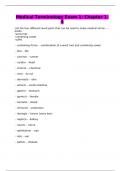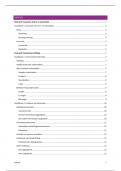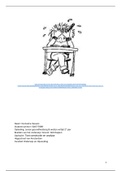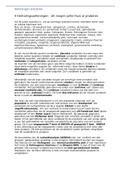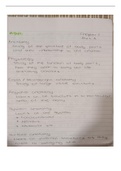Week 5: Diagnosis, Assessment, and Treatment
Week 5.1: Diagnostics and Assessment
DSM-5 Criteria for Substance Use Disorders:
Recommendations and Rationale
Introduction
DSM – the standard classification of mental disorders
- Used for clinical, research, policy, and reimbursement purposes
Proposed Revisions for DSM-5
The largest question – whether to keep abuse and dependence as two separate disorders
Other cross-substance issues – included:
(1) The addition – or removal – of criteria
(2) The diagnostic threshold
(3) Severity indicator/s
(4) Course specifiers
(5) Substance-induced disorders
(6) Biomarkers
Substance-specific issues – included:
(1) New withdrawal syndromes
(2) The criteria for nicotine disorders
(3) Neurobehavioral disorder – associated with prenatal alcohol exposure
Overarching Issues
Should Abuse and Dependence be Kept as Two Separate Disorders?
,Dependence vs Abuse Diagnosis
Dependence – was diagnosed when three or more dependence criteria were met
- Abuse – abuse was diagnosed when at least one abuse criterion was met – among
those without a dependence diagnosis
The Division – DSM-IV
Division into two disorders – was guided by the concept that the “dependence syndrome” –
formed one dimension of substance problems
- While social and interpersonal consequences of heavy use – formed another
The dimensions were assumed to be related – but the DSM-IV placed dependence above
abuse in a hierarchy
- Stipulating that abuse should NOT be diagnosed when dependence was present
The dependence diagnosis – represented a strength of the DSM-IV approach to substance use
disorders
(1) It was consistently shown to be highly reliable
(2) It was validated with antecedent and concurrent indications
- Such as treatment utilization, impaired functioning, consumption, and
comorbidity
Problematic Aspects of DSM-IV Approach
,Some issues pertained to the abuse diagnosis – and others pertained to the stipulated
relationship of abuse to dependence
1. When diagnosed hierarchically – according to DSM-IV
- The reliability and validity of abuse – were much lower than those for
dependence
2. By definition – a syndrome required more than one symptom
- But nearly half of all abuse cases were diagnosed with only one criterion – most
often hazardous use
3. Abuse if often assumed to be milder than dependence
- But some abuse criteria indicate clinically severe problems – e.g., substance-
related failure to fulfil major responsibilities
4. Common assumptions about the relationship of abuse and dependence – were shown
to be incorrect in several studies – e.g., that abuse is a prodromal condition to
dependence
- And that all cases of dependence also met criteria for abuse – concern especially
relevant to women and minorities
The problems pertaining to the DSM-IV hierarchy – of dependence over abuse – also
included “diagnostic orphans”
(1) i.e., the case of two dependence criteria – and no abuse criteria
- potentially a more serious condition than abuse – but ineligible for a diagnosis
When the abuse criteria – were analyzed without regard to dependence – their test-retest
reliability improved considerably
- Suggesting that the hierarchy – not the criteria – led to their poor reliability
Factor analyses of dependence and abuse criteria – formed one factor – or two highly
correlated factors
- Suggesting that the criteria should be combined to represent a single disorder
Item Response Theory Models
Item response theory models – indicate:
(1) Criterion Severity – i.e., rarely endorsed criteria are considered more severe
- Inversely related to frequency
, (2) Discrimination – i.e., how well the criterion differentiated between respondents with
high and low severity of the condition
Curves toward the right – indicate criteria of greater severity
- Steeper slopes – indicate better discrimination
Item Response Theory – Main Findings
First – unidimensionality was found for all DSM-IV criteria for abuse and dependence
- Except legal problems
Indicating – that dependence and the remaining abuse criteria all indicate the same
underlying condition
Second – while severity rankings of criteria varied across studies
- Abuse and dependence criteria – were always intermixed across the severity
spectrum
Collectively – there findings support removing the distinction between abuse and dependence
,FINAL DECISION
For DSM-5 – combine abuse and dependence criteria into one disorder
- With two additional changes indicated below
Should Any Diagnostic Criteria be Dropped?
If any criteria can be removed – while retaining diagnostic accuracy
- The set will be easier to use in clinical practice
The work group – considered whether 2 criteria could be dropped – legal problems and
tolerance
Legal Problems
Reasons to remove legal problems from the criteria set – included:
(1) Very low prevalence in adult samples – and in many adolescent samples
(2) Low discrimination
(3) Poor fit with other substance use disorder criteria
(4) Little added information in item response theory analyses
Not one person with an SUD – reported ONLY having legal problems
Legal problems – found to NOT be a useful substance use disorder criterion
- Although such issues may be important treatment focus in some settings
Tolerance
Concerns about the tolerance criterion – included:
(1) Its operationalization
(2) Occasional poor fit with other criteria
(3) Occasional differential item functioning
(4) Relevance to the underlying disorder
Most item response theory articles – did NOT find anything unique about tolerance relative to
other criteria
FINAL DECISION
Drop legal problems as a DSM-5 diagnostic criteria – but NOT tolerance
,Should Any Criteria Be Added?
If new criteria increase diagnostic accuracy
- The set will be improved by their addition
The work group considered two criteria for possible addition – craving and consumption
Craving
Support for craving as a SUD criterion – comes indirectly from (1) behavioral, (2) imaging,
(3) pharmacology, and (4) genetic studies
- Some believe that craving – and its reduction – is central to diagnosis and
treatment
Craving is included in the dependence criteria in ICD-10
- So, adding craving to DSM-5 – would increase consistency between the
nosologies
The view that adding a craving criterion – may become a biological treatment target – i.e., a
nonpsychometric perspective – prevailed
- Craving can be assessed using questions about (1) strong desire or urge to use, or
(2) such strong desire to use that one could not think of anything else
Consumption
The work group considered adding (1) quantity or (2) frequency of consumption – as a
criterion
Issues of adding this criterion – included:
(1) Worsening of model fit
(2) Unclear utility among cannabis users
(3) Lack of uniform cross-national alcohol indicator
FINAL DECISION
Do NOT add consumption – but DO add “craving or a strong desire or urge to use the
substance” – to the DSM-5 SUD criteria
- Encourage further research on the role of craving among SUD criteria
, What Should the Diagnostic Threshold Be?
SUDs – represent a dimensional condition – with no natural threshold
- However – a binary (yes/no) diagnostic decision is often needed
Threshold of “Two or More” – Selection and Concerns
Prevalence and agreement – based on data from general population and clinical samples
- Appeared maximized with the threshold of two or more criteria – so it was
selected
Concerns
Concerns have been expressed – that the threshold of two or more criteria – is too low
- E.g., it produces an overly heterogenous group – or that those at low severity
levels are not “true” cases
Exception to the Two or More Criteria
An exception to making a diagnosis of DSM-5 SUD – with two criteria – oertains to the
supervised use of psychoactive substances for medical purposes
- Including stimulants, cocaine, opioids, nitrous oxide, anxiolytic drugs, and
cannabis
These substances can produce tolerance and withdrawal – as normal physiological
adaptations when used appropriately
- For supervised medical purposes
With a threshold of two or more criteria – these criteria could lead to invalid SUD diagnoses
– even with no other criteria met
(1) Under these conditions – tolerance and withdrawal in the absence of other criteria
- Do NOT indicate SUD – and should not be diagnosed as such
FINAL DECISION
The diagnostic threshold for DSM-5 – for SUDs is set at two or more criteria
How Should Severity Be Represented?
Week 5.1: Diagnostics and Assessment
DSM-5 Criteria for Substance Use Disorders:
Recommendations and Rationale
Introduction
DSM – the standard classification of mental disorders
- Used for clinical, research, policy, and reimbursement purposes
Proposed Revisions for DSM-5
The largest question – whether to keep abuse and dependence as two separate disorders
Other cross-substance issues – included:
(1) The addition – or removal – of criteria
(2) The diagnostic threshold
(3) Severity indicator/s
(4) Course specifiers
(5) Substance-induced disorders
(6) Biomarkers
Substance-specific issues – included:
(1) New withdrawal syndromes
(2) The criteria for nicotine disorders
(3) Neurobehavioral disorder – associated with prenatal alcohol exposure
Overarching Issues
Should Abuse and Dependence be Kept as Two Separate Disorders?
,Dependence vs Abuse Diagnosis
Dependence – was diagnosed when three or more dependence criteria were met
- Abuse – abuse was diagnosed when at least one abuse criterion was met – among
those without a dependence diagnosis
The Division – DSM-IV
Division into two disorders – was guided by the concept that the “dependence syndrome” –
formed one dimension of substance problems
- While social and interpersonal consequences of heavy use – formed another
The dimensions were assumed to be related – but the DSM-IV placed dependence above
abuse in a hierarchy
- Stipulating that abuse should NOT be diagnosed when dependence was present
The dependence diagnosis – represented a strength of the DSM-IV approach to substance use
disorders
(1) It was consistently shown to be highly reliable
(2) It was validated with antecedent and concurrent indications
- Such as treatment utilization, impaired functioning, consumption, and
comorbidity
Problematic Aspects of DSM-IV Approach
,Some issues pertained to the abuse diagnosis – and others pertained to the stipulated
relationship of abuse to dependence
1. When diagnosed hierarchically – according to DSM-IV
- The reliability and validity of abuse – were much lower than those for
dependence
2. By definition – a syndrome required more than one symptom
- But nearly half of all abuse cases were diagnosed with only one criterion – most
often hazardous use
3. Abuse if often assumed to be milder than dependence
- But some abuse criteria indicate clinically severe problems – e.g., substance-
related failure to fulfil major responsibilities
4. Common assumptions about the relationship of abuse and dependence – were shown
to be incorrect in several studies – e.g., that abuse is a prodromal condition to
dependence
- And that all cases of dependence also met criteria for abuse – concern especially
relevant to women and minorities
The problems pertaining to the DSM-IV hierarchy – of dependence over abuse – also
included “diagnostic orphans”
(1) i.e., the case of two dependence criteria – and no abuse criteria
- potentially a more serious condition than abuse – but ineligible for a diagnosis
When the abuse criteria – were analyzed without regard to dependence – their test-retest
reliability improved considerably
- Suggesting that the hierarchy – not the criteria – led to their poor reliability
Factor analyses of dependence and abuse criteria – formed one factor – or two highly
correlated factors
- Suggesting that the criteria should be combined to represent a single disorder
Item Response Theory Models
Item response theory models – indicate:
(1) Criterion Severity – i.e., rarely endorsed criteria are considered more severe
- Inversely related to frequency
, (2) Discrimination – i.e., how well the criterion differentiated between respondents with
high and low severity of the condition
Curves toward the right – indicate criteria of greater severity
- Steeper slopes – indicate better discrimination
Item Response Theory – Main Findings
First – unidimensionality was found for all DSM-IV criteria for abuse and dependence
- Except legal problems
Indicating – that dependence and the remaining abuse criteria all indicate the same
underlying condition
Second – while severity rankings of criteria varied across studies
- Abuse and dependence criteria – were always intermixed across the severity
spectrum
Collectively – there findings support removing the distinction between abuse and dependence
,FINAL DECISION
For DSM-5 – combine abuse and dependence criteria into one disorder
- With two additional changes indicated below
Should Any Diagnostic Criteria be Dropped?
If any criteria can be removed – while retaining diagnostic accuracy
- The set will be easier to use in clinical practice
The work group – considered whether 2 criteria could be dropped – legal problems and
tolerance
Legal Problems
Reasons to remove legal problems from the criteria set – included:
(1) Very low prevalence in adult samples – and in many adolescent samples
(2) Low discrimination
(3) Poor fit with other substance use disorder criteria
(4) Little added information in item response theory analyses
Not one person with an SUD – reported ONLY having legal problems
Legal problems – found to NOT be a useful substance use disorder criterion
- Although such issues may be important treatment focus in some settings
Tolerance
Concerns about the tolerance criterion – included:
(1) Its operationalization
(2) Occasional poor fit with other criteria
(3) Occasional differential item functioning
(4) Relevance to the underlying disorder
Most item response theory articles – did NOT find anything unique about tolerance relative to
other criteria
FINAL DECISION
Drop legal problems as a DSM-5 diagnostic criteria – but NOT tolerance
,Should Any Criteria Be Added?
If new criteria increase diagnostic accuracy
- The set will be improved by their addition
The work group considered two criteria for possible addition – craving and consumption
Craving
Support for craving as a SUD criterion – comes indirectly from (1) behavioral, (2) imaging,
(3) pharmacology, and (4) genetic studies
- Some believe that craving – and its reduction – is central to diagnosis and
treatment
Craving is included in the dependence criteria in ICD-10
- So, adding craving to DSM-5 – would increase consistency between the
nosologies
The view that adding a craving criterion – may become a biological treatment target – i.e., a
nonpsychometric perspective – prevailed
- Craving can be assessed using questions about (1) strong desire or urge to use, or
(2) such strong desire to use that one could not think of anything else
Consumption
The work group considered adding (1) quantity or (2) frequency of consumption – as a
criterion
Issues of adding this criterion – included:
(1) Worsening of model fit
(2) Unclear utility among cannabis users
(3) Lack of uniform cross-national alcohol indicator
FINAL DECISION
Do NOT add consumption – but DO add “craving or a strong desire or urge to use the
substance” – to the DSM-5 SUD criteria
- Encourage further research on the role of craving among SUD criteria
, What Should the Diagnostic Threshold Be?
SUDs – represent a dimensional condition – with no natural threshold
- However – a binary (yes/no) diagnostic decision is often needed
Threshold of “Two or More” – Selection and Concerns
Prevalence and agreement – based on data from general population and clinical samples
- Appeared maximized with the threshold of two or more criteria – so it was
selected
Concerns
Concerns have been expressed – that the threshold of two or more criteria – is too low
- E.g., it produces an overly heterogenous group – or that those at low severity
levels are not “true” cases
Exception to the Two or More Criteria
An exception to making a diagnosis of DSM-5 SUD – with two criteria – oertains to the
supervised use of psychoactive substances for medical purposes
- Including stimulants, cocaine, opioids, nitrous oxide, anxiolytic drugs, and
cannabis
These substances can produce tolerance and withdrawal – as normal physiological
adaptations when used appropriately
- For supervised medical purposes
With a threshold of two or more criteria – these criteria could lead to invalid SUD diagnoses
– even with no other criteria met
(1) Under these conditions – tolerance and withdrawal in the absence of other criteria
- Do NOT indicate SUD – and should not be diagnosed as such
FINAL DECISION
The diagnostic threshold for DSM-5 – for SUDs is set at two or more criteria
How Should Severity Be Represented?



